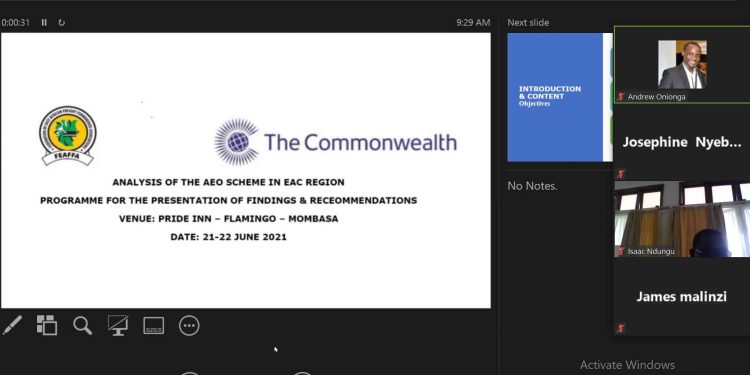The Authorised Economic Operators (AEO) programme run by the Customs Authorities in the East African region has failed to record a good uptake since some of the benefits it has outlined are not available, industry stakeholders meeting in Mombasa to discuss findings of a study carried recently to analyze issues affecting the programme in the region said.
The Federation of the East African Freight Forwarders Associations (FEAFFA) with the support of the Commonwealth presented the study findings to participants drawn from the East Africa region who are meeting in a Mombasa hotel.
Other factors affecting slow uptake include lack of adequate sensitization among the industry stakeholders and tedious application processes that take long without sufficient guarantee that one will finally get accreditation.
Small and Medium Micro Enterprises (SMME) are cost disadvantaged and are not able to keep the high standards and stringent measures that are employed by customs in vetting the AEOs, the study reveals.
There is also lack of harmony and standard application and accreditation procedures, which affects the regional AEOs uptake. Other factors include fear of exposure and a perception that the process is not transparent.
The uptake has been averaging 27 economic operators authorized each year between 2015 and 2019. Majority of the operators currently reporting benefits from the AEO program are by default relatively large operators. Smaller operators expressed feelings of exclusion and low value for money, the study revealed.
Threshold to bring SMME on AEOs programme is very high, according to Stephen Analo, the principal Customs expert (Capacity building) at the East African Community (EAC).
“The regulators should clearly outline the benefits of the AEO scheme and let the programme market and speak for itself,” he said.
Humphrey Asiimwe from Uganda said that efforts to facilitate trade in the region in recent years has seen the governments provide many incentives that were originally enjoyed by AEOs. There is, therefore, a continuous need to come up with new incentives to make the programme attractive to the operators, he said.
“In places like South Korea, Europe and the United States (USA), to enhance the supply chain security, AEO programmes have incorporated other agencies such as the bank and insurance companies,” Asiimwe said.
There has been a consistent lack of enthusiasm by both the private sector and regulators. This has resulted in the programme being affected by small administrative challenges such as staff reshuffle that moves the AEO programme to ground zero when new staff not trained on it take over.
“There is a clear lack of motivation. The application process is very complex and the AEOs programmes are not known or recognized by other agencies save for customs and Bureau of Standards,” Roy Mwanthi, Kenya International and Warehousing Association (KIFWA) Chairman said, adding that a perception of corruption was real.
Importers and exporters registered for AEO in Kenya, for instance, stood at 155 importers since the programme started in 2006. With only 83 registered in the programme, clearing agents take the second position. However, this number is low considering that the KIFWA has registered over 560 and 780 clearing agents in Mombasa and Nairobi respectively.
There are only 7 transporters enrolled in the programme. Kenya Transporters Association (KTA) has over 200 registered members with a significantly huge proportion of transporters, especially those with few trucks not being members. There is only one ship agent enrolled in the programme, according to KRA. Therefore, this means that the importers cannot enjoy services by AEOs in the entire logistics chain.
The AEO program was conceived by the Commissioners of Customs of the East African (EAC) countries of Burundi, Kenya, Rwanda, Tanzania and Uganda in 2006 after the adoption of the World Customs Organization (WCO) SAFE Framework of Standards by the WCO Council in 2005.
“The Commissioners’ decision was in line with the EAC Protocol that requires the EAC region to set up a Customs Union as one of the building blocks for regional integration,” East African Community (EAC) secretariat posts in a brief on its website.
The decision was also prompted by the consideration that since the AEO program is about trade facilitation and the security of the supply chain, traders and Customs stood to gain more if the whole supply chain within the region is covered under one program.
The AEO aims to enhance Customs efficiency in the face of increasing volumes of trade and the increasing vulnerability of the international trade supply chain to security threats as well as the use of the international trade supply chain as a conduit for high security risk materials.
The AEO program tackles these challenges by shifting the perspective, so that instead of focusing on the goods themselves, Customs focuses on the traders.
“The compliant traders are therefore given the AEO status which means they are low risk companies and can therefore be trusted by Customs,” EAC said, adding that this implies that Customs can handle the consignments of such companies with less controls compared to others thus the program serving as an instrument for growing compliance.
The AEO program is designed to facilitate and enhance the experience of the complaint trader when undergoing Customs clearance processes.
There are both the national and regional AEOs. The EAC Regional AEO program covers and is applicable in all the Partner States namely Burundi, Kenya, Rwanda, Tanzania and Uganda save for the Republic of South Sudan which was not a member Partner State of EAC at the commencement of the programme.
The regional AEO program operates under a common set of criteria, instruments, authorisation process, benefits and monitoring system in all the Partner States. An applicant for AEO Status, irrespective of the Partner State, therefore, is supposed to go through.





